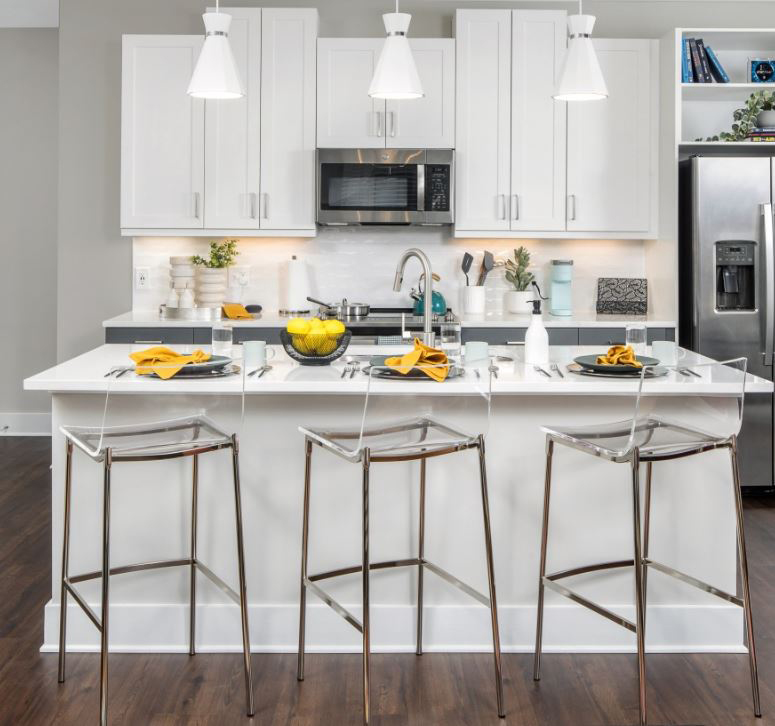Thermofoil is a surface finish made from a thin layer of plastic. The term comes from “thermo,” meaning heat, and “foil” for a thin sheet. This material is often used to cover and protect wood-based substrates. It is composed of several layers, each contributing to its unique characteristics and performance.

Advantages of using Thermofoil
- Visual Versatility: Thermofoil is available in an extensive range of colors, patterns, and textures, allowing for endless design possibilities. Whether mimicking natural wood grains or delivering bold solid colors, thermofoil can effortlessly adapt to any aesthetic.
- Cost-Effective Elegance: One of the most notable benefits of thermofoil is its cost-effectiveness. It offers the appearance of high-end materials like wood or lacquer at a fraction of the cost. This affordability has made it a preferred choice for both budget-conscious homeowners and professionals managing larger projects.
- Durability and Low Maintenance: Thermofoil surfaces are resistant to moisture, heat, and staining, making them ideal for environments such as kitchens and bathrooms. Unlike natural wood, thermofoil doesn’t require sealing or frequent refinishing, reducing the maintenance burden on users.
- Seamless Application: The heat-fusing process ensures a seamless, edge-to-edge application that eliminates visible seams or joints. This quality is particularly beneficial for cabinet doors and other furniture pieces where a uniform appearance is crucial.
- Ease of Cleaning: Thermofoil surfaces can be easily cleaned with mild soap and water, making them well-suited for areas prone to spills and splatters.
- Consistency: Unlike natural materials that can exhibit variations in color and grain, thermofoil offers consistent color and pattern throughout its surface.
Also Read – Are Thermofoil Cabinet Doors Right for Your Multifamily Project?
Other applications
Thermofoil is most used for cabinets but there are other applications its’s used for as well.
- Cabinetry: Thermofoil cabinet doors have become a staple in modern kitchens and bathrooms. They provide a sleek, uniform appearance that complements contemporary design trends.
- Furniture: Thermofoil is commonly used for furniture pieces such as dressers, desks, and entertainment centers. Its durability and visual appeal make it an excellent choice for both residential and commercial settings.
- Interior Doors: Thermofoil-coated interior doors offer an attractive alternative to traditional wood doors, with the added benefit of resistance to humidity-related issues.
- Retail Displays: Thermofoil’s ability to mimic various textures and colors makes it a favored material for retail displays and fixtures.
Challenges and Considerations
Thermofoil is a material well-loved and used by many multifamily projects and homeowners due to its amazing advantages, however there can be challenges with this material. Before purchasing you should consider.
- Heat Sensitivity: While thermofoil surfaces are heat-resistant to some extent, prolonged exposure to extreme heat can cause the material to warp or delaminate.
- Limited Repair Options: Unlike solid wood, thermofoil surfaces are not easily repairable if they are damaged. Replacing an entire panel may be necessary.
- Susceptibility to Peeling: Poor manufacturing quality or improper installation can lead to issues like peeling or delamination over time, which is why it is important to find quality manufacturers such as Republic Elite when purchasing thermofoil.
Conclusion
Thermofoil stands as a testament to the marriage of technology and design innovation. Its ability to provide cost-effective elegance, durability, and versatility has cemented its place in contemporary interior design. Whether adorning kitchen cabinets, furniture pieces, or other applications, thermofoil continues to be a reliable choice for those seeking both aesthetic appeal and functional performance in their living spaces. As technology and materials evolve further, thermofoil remains a shining example of how ingenuity can reshape our built environments.


